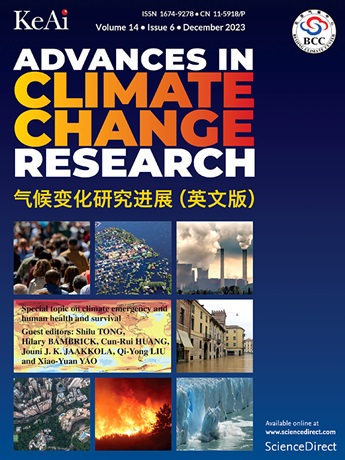美丽中国面临的未来气候风险:2035年和2050年展望
IF 5.2
1区 地球科学
Q1 ENVIRONMENTAL SCIENCES
引用次数: 0
摘要
在“美丽中国”的实施过程中,确定气候灾害高发地区及其重叠区域,填补了灾害风险研究的一个关键空白,这一空白往往缺乏对多种灾害综合风险的定量分析。本研究评估了可能影响2035年和2050年“美丽中国”目标的主要气候风险及其重叠部分,包括暴雨、热浪和干旱。该分析基于三个共享的社会经济路径(SSP126、SSP370和SSP585),包括脆弱性、灾害风险和暴露水平。研究结果表明,随着时间的推移和气候变暖,中国气候风险的严重程度将加剧。西部地区将面临更加严峻的单一气候风险,东部地区将面临更加严峻的综合气候风险。在西部地区,预计到2035年,新疆塔里木盆地将经历超过5级的热浪风险,而西藏和青海将面临超过6级的干旱风险。到2050年,更多地区将升级为6级和7级风险。在东部地区,到2035年,山东、河南、珠江三角洲和京津冀地区预计将面临暴雨、热浪和干旱的综合风险。到2050年,重叠的高风险区域将扩大,覆盖长江经济带东部。此外,较高的辐射强迫情景与风险增加有关。本研究为中国不同地区制定有针对性的灾害预防和管理系统提供了重要见解,为有效实施“美丽中国”倡议提供了指导。本文章由计算机程序翻译,如有差异,请以英文原文为准。

Future climatic risks faced by the Beautiful China Initiative: A perspective for 2035 and 2050
Identifying high-risk areas for climatic disasters and their overlaps during the implementation of the Beautiful China Initiative fills a critical gap in disaster risk research, which often lacks quantitative analyses of the combined risks from multiple disasters. This study evaluates key climatic risks and their overlaps, including heavy storms, heatwaves, and droughts, that may affect the Beautiful China Initiative objectives in 2035 and 2050. The analysis is based on three shared socioeconomic pathways (SSP126, SSP370, and SSP585), incorporating vulnerability, disaster risks, and exposure levels. The findings indicate that the severity of climatic risks in China will intensify over time and with climate warming. The western regions will face more severe single-climate risks, while the eastern regions will encounter increasingly severe comprehensive climatic risks. In the western regions, by 2035, the Tarim Basin in Xinjiang is projected to experience heatwave risks exceeding Level 5, while Tibet and Qinghai will face drought risks above Level 6. By 2050, more areas will escalate to Level 6 and 7 risks. In the eastern regions, by 2035, Shandong, Henan, the Pearl River Delta, and the Beijing, Tianjin, Hebei region are expected to face comprehensive risks from heavy storms, heatwaves, and droughts. By 2050, the overlapping high-risk areas will expand, covering the eastern parts of the Yangtze River Economic Belt. Furthermore, higher radiative forcing scenarios are associated with increased risks. This study provides critical insights for developing targeted disaster prevention and management systems across different regions of China, offering guidance for the effective implementation of the Beautiful China Initiative.
求助全文
通过发布文献求助,成功后即可免费获取论文全文。
去求助
来源期刊

Advances in Climate Change Research
Earth and Planetary Sciences-Atmospheric Science
CiteScore
9.80
自引率
4.10%
发文量
424
审稿时长
107 days
期刊介绍:
Advances in Climate Change Research publishes scientific research and analyses on climate change and the interactions of climate change with society. This journal encompasses basic science and economic, social, and policy research, including studies on mitigation and adaptation to climate change.
Advances in Climate Change Research attempts to promote research in climate change and provide an impetus for the application of research achievements in numerous aspects, such as socioeconomic sustainable development, responses to the adaptation and mitigation of climate change, diplomatic negotiations of climate and environment policies, and the protection and exploitation of natural resources.
 求助内容:
求助内容: 应助结果提醒方式:
应助结果提醒方式:


